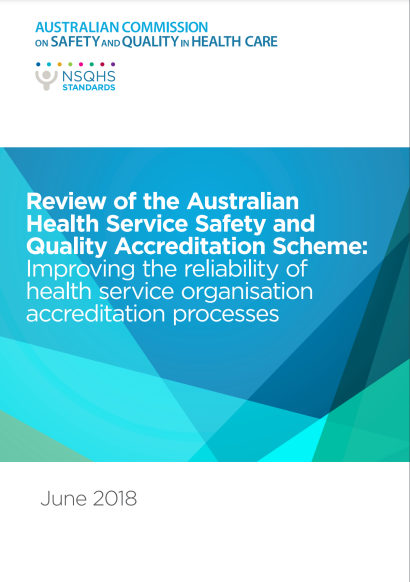Australian Health Service Safety and Quality Accreditation Scheme
The AHSSQA Scheme provides for the national coordination of accreditation processes.
On this page:
Background to the AHSSQA Scheme
Under the National Health Reform Act 2011, the Australian Commission on Safety and Quality in Health Care (the Commission) is responsible for the formulation of standards relating to health care safety and quality matters. This includes formulating and coordinating the Australian Health Service Safety and Quality Accreditation Scheme (the AHSSQA Scheme), which provides for the national coordination of accreditation processes.
The AHSSQA Scheme sets out the responsibilities of accrediting agencies in relation to implementation of the following safety and quality standards:
- National Safety and Quality Health Service (NSQHS) Standards including the:
- Multi-Purpose Services Aged Care (MPS) Module
- National Clinical Trials Governance Framework
- National Safety and Quality Digital Mental Health (NSQDMH) Standards
- National Safety and Quality Primary and Community Healthcare (NSQPCH) Standards
- Mental Health Standards for Community Managed Organisations
- and any other set of standards that may be developed by the Commission from time to time.
Collecting and analysing feedback on the lessons learnt through accreditation is an essential part of quality improvement. The Commission uses feedback to identify areas where health services may require additional support or tools and to maintain and update the safety and quality standards developed by the Commission.
Improvement across the health care system can be achieved when feedback from the assessment of health service organisations is used by:
- State and territory health departments– to support health service improvement and facilitate better understanding for health service organisations about their quality of care
- The Commission – to develop resources and tools to support good practice and to maintain the currency of the safety and quality standards
- Health Ministers – to drive policy direction and investment around safety and quality
The AHSSQA Scheme consists of five inter-related elements to support the application of the safety and quality standards. The roles of each are broadly as follows:
- Health Ministers endorse the standards and receive information about health service organisations’ performance against these standards.
- The state, territory and Commonwealth governments determine the health service organisations required to be assessed against which set of safety and quality standards (as listed above). They receive data on the outcomes of assessment of health service organisations and respond to emerging issues.
- Health service organisations implement the actions required to meet the specific safety and quality standards and select an approved accrediting agency to assess their compliance in meeting these standards. This involves a contractual relationship with the accrediting agency that recognises assessment data will be provided to state and territory health departments and the Commission for reporting and review.
- The approved accrediting agencies assess health service organisations against the specified standards. They may also offer to assess a limited range of approved standards concurrently.
- The Commission, through coordination of a national program, will:
- Develop and maintain the safety and quality standards (as listed above)
- Approve accrediting agencies to assess health service organisations against the safety and quality standards
- Undertake ongoing liaison with state and territory health departments on opportunities to improve the Standards and the accreditation system
- Report to health Ministers annually on safety and quality.
- Information on the operation of the AHSSQA Scheme is contained in a series of fact sheets.
Review of the AHSSQA Scheme
In 2017/18 the Commission undertook a comprehensive review of assessment processes and the performance of accrediting agencies. This was done following feedback from state and territory regulators and chief executives of health service organisations, who identified concerns with some aspects of the AHSSQA Scheme, including its ability to reliably verify an organisation’s safety and quality systems. As a result, the Commission developed six strategies to improve the AHSSQA Scheme’s reliability to more accurately assess an organisation’s compliance. These strategies are to:
- Improve the veracity of health service organisation assessments
- Improve the effectiveness and expertise of the assessment team
- Assess the health service organisation’s safety and quality data to better inform assessment processes
- Improve regulatory oversight
- Improve communication about the assessments and their outcomes
- Improve resources and support for health service organisations.
Further details about the outcome of the review can be found in this document:
The implementation of changes to the AHSSQA Scheme commenced in January 2019 under the first strategy Improving the veracity of health service organisation assessments. The Commission contracted four literature reviews on assessment methodologies being considered:
